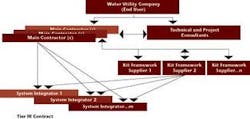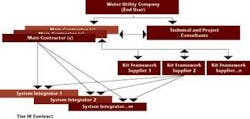By Satish Gundi
Changing the major emphasis from "automation" to "integration" using one supplier can help water companies achieve better control on contracts and a higher degree of standardisation.
Water companies face increasing pressure to improve returns on investment done through large programmes, such as the Asset Management Programme.
Companies are finding innovative ways to maintain service quality with a reduced cost of ownership. The control system is one area that plays a vital role in meeting business objectives, including safety, legal compliance, quality of service and productivity.
Most of the control systems available in the market are reliable and meet automation needs. What differentiates one from the other is the way these systems are integrated, engineered and maintained for specific applications. Control systems integration affects significantly the total life cycle cost of ownership of control systems. The typical role of a control system integrator is:
• Study of process design documents and detailing control philosophies;
• Hardware design;
• Software design;
• Development of application software (including graphics and SCADA)
• Factory acceptance testing;
• Commissioning of the control systems.
Water companies typically follow a model (Figure 1) where control system integration services are embedded within other contracts. These contracts are often second or third Tier subcontracts engaged through the main contractors or kit framework suppliers. Although the model would be similar across water companies, the exact approach may vary from company to company.
Automation, rather than integration is the major emphasis in this approach. This results in having multiple control system integrators across different plants. It is very likely that for ten different projects, one would find 10 different solutions to a problem. Each would be correct but different.
The common problems faced with such an arrangement are:
• Multiple control system designs;
• Very little or no emphasis on integration specifications or documentation;
• Potential issues in the commissioning and support of the systems;
• No common work methodology or processes.
Clearly, implementing organisational standards and following consistent design methodologies can solve these problems. However, in reality this is difficult as the water company has little control on the management of these system integrators.
An innovative approach could be to change the engagement model and procure control system integration as Tier 1 services.
Instead of engaging multiple system integrators, a water company can separate out these engineering services as a separate sub-contract. This model allows one to have better control on expected output from these suppliers and achieves higher degree of standardisation (Figure 2). Once agreed, the method of solving a problem is common across all of a company's plants.
Although there are risks associated with using a single supplier, considerable benefits can also be achieved with this approach. Due to standardisation, a company would see:
• Modular software and consistent design across all plants;
• Optimal use of hardware;
• Reduction in cost due to reusability of components;
• Easier maintenance;
• Improved efficiency;
• Standardised documentation;
• Better control of output;
• Cost advantage due to scale.
Some inherent challenges must be addressed although implementation of this approach appears simple. A change in contract management process is required. One may have to eliminate preferences in engineering. Investment in standardisation is required. Better coordination is necessary as the sole systems integrator deals with multiple agencies.
The best entity to drive this approach is the end user as goods or service providers may not necessarily match a company's business goals. With major benefits to be achieved through this approach, however, the question is "Are you willing to invest enough effort upfront in managing and controlling systems integration?"
Author's Note
Satish Gundi is the business development manager for plant solutions at Tata Consultancy Services, located in Manchester, England. He can be reached at Email: [email protected].





